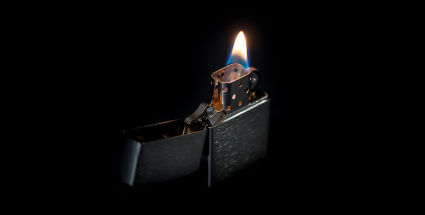
Invented even before the match, the lighter that we know today is the direct descendent of the techniques used by our prehistoric ancestors to tame fire. What spark of genius meant that this little flame in our pocket became part of everyday life, to light our pipe, cigar or cigarette, as well our wood-burning stoves and inserts?
Taming fire, for which the most convincing scientific evidence dates back 400,000 years, was a crucial moment in our prehistoric times. Indeed, learning how to master fire meant that our ancestors could keep predators away, cook food, produce new tools, but most importantly... keep warm! Taming the flame well and truly began with a skill that is particularly close to Stûv’s heart: lighting a fire. The very first methods included a striking action, which is the technique used by the lighter. This involves striking two hard materials against each other until a spark is created that is hot enough to ignite a fuel.
This seemingly simple technique nevertheless had to be refined over thousands of years before proving its efficacy. Indeed, to produce a spark that is enough to light a fire, homo sapiens had to try out lots of different combinations, as striking flint against flint was not very satisfactory. Finally, it was around 15,000 years ago in Europe that we find the origins of the lighter technique: striking a siliceous rock against some iron ore (pyrite or marcasite) to light amadou was the winner that became the very first lighter. Eventually, steel replaced pyrite to produce a greater number of larger, hotter sparks. The oldest form of lighter was born: the flint lighter, still used in some parts of the world.
The arrival of the gas lighter was a bit of a revolution. Invented by Frenchman Henry Pingeot and marketed by Marcel Quercia, the first pocket lighter, the Crillon, appeared in 1948. And what an innovation it was! With the click of your fingers, the spark produced ignites the small amount of gas released. Once the reservoir was empty, there was no question of throwing it away: just go to a newsagent to get it refilled. We had to wait until the 1970s to see the first disposable lighters in Paris, made by Bic, today’s market leader. This little plastic object with such a familiar design is now a real celebrity, and is even part of the permanent “Architecture and Design” collection at the Museum of Modern Art (MoMa) in New York.
Another celebrity, the Zippo, is originally from Pennsylvania, introduced by a creative talent in search of aesthetics, simplicity and reliability. Which is what Stûv’s philosophy is all about! In 1931, Georges Blaisdell had the brilliant idea of designing a storm lighter (with petrol) with the addition of a hinged top: skilful users manage to open and light it in one motion. Named Zippo in reference to another revolution, the zip, this designer lighter soon went down in history.
Disposable or a collector’s item, an heirloom or a contemporary tool, the lighter has become a staple in our homes. A small object with a great history!